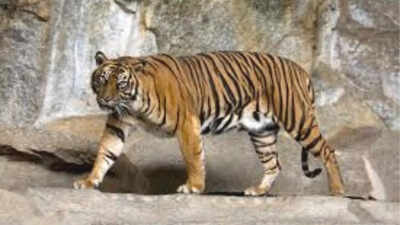Sumatran tiger is the world’s ‘rarest’ tiger: Know its traits and unique facts |

The animal world is full of amazements, but few animals fascinate us as much as the Sumatran tiger, the rarest tiger in the world. A mysterious and awe-inspiring creature, the Sumatran tiger is living proof of the genius of nature. With its beautiful looks and distinctive habits, the Sumatran tiger distinguishes itself from its more popular cousins. From its lush forest home to its survival struggles, each fact about this tiger is a testament to its resilience and uniqueness. As conservation continues to shield this regal creature, learning about its characteristics and secrets provides insight into the fragile harmony of our world’s ecosystems. Dive in to learn what makes the Sumatran tiger so one-of-a-kind.
Sumatran tiger key characteristics
Sumatran tiger: Size and weight
Sumatran tigers are large, powerful animals. Males typically weigh between 200 to 310 pounds, while females range from 180 to 300 pounds. Their length, including the tail, can reach 9 to 12 feet. Despite their impressive size, tigers have very little body fat, and their mass consists mainly of muscle and bone. This gives them a sleek, powerful build, allowing them to move swiftly when needed. Their weight and size also help them take down large prey, which is essential for their survival in the wild. Their strength is one of the key adaptations to their environment.
Sumatran tiger: Physical features
Sumatran tigers have distinct physical features, with close-set stripes, long cheek hair, and a short neck mane. Their stripes are unique to each individual, making it possible to identify them based on these markings. These tigers are excellent swimmers, thanks to specialized webbing between their toes, which helps them navigate through water with speed and agility. The webbing also gives them an advantage when hunting prey near rivers or lakes. Additionally, they can perform incredible feats of strength and agility, with vertical jumps up to 16 feet and horizontal jumps of around 27 feet.
Sumatran tiger: Lifestyle and reproduction
Sumatran tigers are solitary animals, except for brief periods of courtship or when a female is raising cubs. Females typically reach sexual maturity between 4 to 5 years old and go into heat every 3 to 9 weeks. During mating, tigers engage in copulation about 100 times over a 2-3 day period, which stimulates ovulation in the female. After a gestation period of about 100 days, the female gives birth to 1 to 6 cubs, which are born blind and weigh around 2 pounds. Cubs stay with their mothers for up to two years, learning vital survival skills.
Sumatran tiger: Habitat
Sumatran tigers are found only on the Indonesian island of Sumatra, where they inhabit rainforests. Unlike most other big cats, these tigers are highly adapted to aquatic environments. They enjoy swimming and are well-equipped for it, with webbed toes that allow them to move efficiently through water. The dense, tropical forests of Sumatra provide excellent cover for these elusive creatures, allowing them to camouflage effectively. While they are skilled swimmers, tigers are also capable of thriving in the challenging rainforest terrain, where they can stalk their prey and navigate the dense vegetation with ease.
Sumatran tiger: Diet
As strict carnivores, Sumatran tigers have a varied diet that includes large prey such as deer, wild boar, and smaller animals like lizards, frogs, fish, and crabs. Their strong hunting skills and powerful jaws allow them to catch and consume a wide range of animals. At Zoo Atlanta, these tigers are offered up to 10 pounds of specially prepared tiger diet, made from entire beef carcasses, to simulate their natural feeding habits. Additionally, they are provided with large bones, which they manipulate and chew to keep their teeth healthy. This feeding strategy mimics the challenges they would face in the wild.
Sumatran tiger: Enrichment
In captivity, it’s crucial to provide tigers with enrichment to keep them mentally and physically stimulated. At Zoo Atlanta, Sumatran tigers are offered durable, large toys such as hard-plastic balls and empty kegs, which encourage them to engage in natural behaviors like batting and chewing. Additionally, they are introduced to novel scents, which activate their keen sense of smell and promote investigative behavior. Enrichment is vital for preventing boredom and ensuring that the tigers remain active and healthy. These activities also provide an opportunity for the tigers to express natural instincts and maintain their well-being in captivity.
7 lesser known facts about Sumatran tiger
- They possess unique genetic characteristics that differ from mainland tigers according to mitochondrial DNA.
- They inhabit densely forested country with steep hills and higher terrain, shunning regions of much human activity.
- Sumatran tigers are the smallest subspecies of tigers, males weighing 100-140 kg and females lighter.
- Their more blackish-coloured fur includes wider stripes and tiny spots within them, an unusual pattern amongst tigers.
- Kerinci Seblat Park has the highest number of Sumatran tigers, with 165 to 190 individuals.
- Four cubs were born in July 2024 at Wrocław Zoo in Poland, a significant conservation achievement.
- They are threatened by serious deforestation, poaching, and human conflict, which endanger them with extinction.
Also Read: Does God exist? New mathematical formula suggests God is real, claims Harvard scientist








